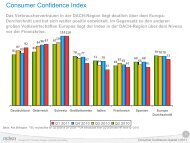You also want an ePaper? Increase the reach of your titles
YUMPU automatically turns print PDFs into web optimized ePapers that Google loves.
Equally different<br />
All teens are not alike, and grouping them together could be<br />
a roadmap for disaster. Take, for example, a typical eighth<br />
grader compared with a college student. While Disney’s<br />
“High School Musical” is all the rage for one, the other is<br />
much more engaged by the latest drama on MTV’s “The<br />
Real World.”<br />
And don’t discount the hugely important gender differences.<br />
Anybody with kids knows how different boys are from girls.<br />
Therefore, when analyzing teens, boys and girls need to be<br />
viewed separately. For example, girls believe that they are<br />
more grown-up than boys, and spend their money on very<br />
different things, such as jewelry and clothing, while boys’<br />
interests trend toward games and electronics. However, both<br />
spend money on music and movies, which increases as kids<br />
shift from the 12–14 age bracket to the 15–17 one.<br />
It is also important to realize that “what’s hot” can be<br />
polarizing, because for each teen fad with adoring fans,<br />
there is a subset of teens who simply hate it. Finding a teen<br />
idol as a spokesperson for a brand could divide an audience.<br />
For each loyal fan of Justin Timberlake, there is another<br />
teen who simply abhors him. Interestingly, this love/hate<br />
relationship seems to be more common with the “beautiful<br />
people” than with stars like John Heder or Jack Black, who<br />
garner more universal appeal.<br />
Stay ahead of the curve<br />
For the most part, young people take their cues from those<br />
a few years older than themselves for trends. This may be<br />
why the Harry Potter books and movies which feature teens<br />
have their strongest appeal to younger children. Or why<br />
movies with a PG-13 rating are more enticing to teens. Or<br />
why Paris Hilton, who is in her mid-twenties, is a fashion<br />
icon for many teenage girls.<br />
Whether the new fashion is Crocs or Lacoste, whether the<br />
latest video craze is Nintendo DS Lite or GameTap, you<br />
can be sure of one thing: what’s hot today is not tomorrow.<br />
Rather than focusing on what’s hot right now, it is more<br />
important to develop tools and approaches to monitor and<br />
anticipate changes.<br />
For example, tap into the fickle world of teen trends by<br />
checking out websites such as Billboard.com for the most<br />
popular ringtones, which btw, as of this writing, is the<br />
Nintendo Super Mario Brothers Theme by Koji Kondo, or<br />
the hottest digital songs (Fergie’s London Bridge), or number<br />
one album (the self-named Danity Kane), or top single<br />
(Justin Timberlake’s “SexyBack”). Another popular teen<br />
website is MySpace.com, where teens connect with others,<br />
blog, rank music, and much more.<br />
Cash or credit<br />
The fact of the matter is, teenagers represent a powerful<br />
buying force in the U.S. market. According to the 2005<br />
Roper Youth Report, kids are earning $29.20 per week, two<br />
dollars more than in 2004, with 29% of their money coming<br />
straight from parents. Chores (37%) and gifts (23%)<br />
account for other popular sources of teen income. Nearly<br />
one-third (30%) of 8–17-year-olds say they are involved in<br />
making family purchase decisions, up four percentage points<br />
from last year, as parents increasingly turn to their kids for<br />
advice on what to buy. Teens also indicate that they influence<br />
purchase decisions on everything from cell phone service<br />
to the right cable provider.<br />
For better or worse (probably the latter), teens are also<br />
enamored by the magic of credit. According to the<br />
Jump$tart Coalition for Personal Financial Literacy, an educational<br />
organization, nearly a third of high school seniors<br />
reported having a credit card of their own or one co-signed<br />
by a parent.<br />
22 Fall/Winter 2006











